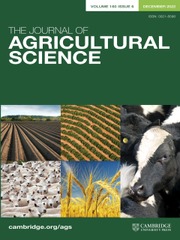Crossref Citations
This article has been cited by the following publications. This list is generated based on data provided by
Crossref.
Bamford, S.J.
Parker, C.J.
and
Carr, M.K.V.
1991.
Effects of soil physical conditions on root growth and water use of barley grown in containers.
Soil and Tillage Research,
Vol. 21,
Issue. 3-4,
p.
309.
Majdi, Hooshang
Smucker, Alvin J. M.
and
Persson, Hans
1992.
A comparison between minirhizotron and monolith sampling methods for measuring root growth of maize (Zea mays L.).
Plant and Soil,
Vol. 147,
Issue. 1,
p.
127.
Bengough, A. G.
Mackenzie, C. J.
and
Diggle, A. J.
1992.
Relations between root length densities and root intersections with horizontal and vertical planes using root growth modelling in 3-dimensions.
Plant and Soil,
Vol. 145,
Issue. 2,
p.
245.
Volkmar, K. M.
1993.
A comparison of minirhizotron techniques for estimating root length density in soils of different bulk densities.
Plant and Soil,
Vol. 157,
Issue. 2,
p.
239.
Samson, Benjamin K.
and
Sinclair, Thomas R.
1994.
Soil core and minirhizotron comparison for the determination of root length density.
Plant and Soil,
Vol. 161,
Issue. 2,
p.
225.
Smit, A. L.
Groenwold, J.
and
Vos, J.
1994.
The Wageningen Rhizolab ? a facility to study soil-root-shoot-atmosphere interactions in crops.
Plant and Soil,
Vol. 161,
Issue. 2,
p.
289.
Chotte, J.L.
Laurent, J.Y.
and
Rossi, J.P.
1995.
A modified hydropneumo‐elutriation apparatus for quantitative root separation from large soil core samples.
Communications in Soil Science and Plant Analysis,
Vol. 26,
Issue. 15-16,
p.
2703.
Becker, G.F.
Busso, C.A.
Montani, T.
Burgos, M.A.
Flemmer, A.C.
and
Toribio, M.B.
1997.
Effects of defoliatingStipa tenuisandPiptochaetium napostaenseat different phenological stages: root growth.
Journal of Arid Environments,
Vol. 35,
Issue. 2,
p.
269.
Pan, W.L.
Bolton, R.P.
Lundquist, E.J.
and
Hiller, L.K.
1998.
Portable rhizotron and color scanner system for monitoring root development.
Plant and Soil,
Vol. 200,
Issue. 1,
p.
107.
Pan, W. B.
Bolton, R. P.
Lundquist, E. J.
and
Hiller, L. K.
1998.
Root Demographics and Their Efficiencies in Sustainable Agriculture, Grasslands and Forest Ecosystems.
p.
745.
Ephrath, J. E.
Silberbush, M.
and
Berliner, P. R.
1999.
Calibration of minirhizotron readings against root length density data obtained from soil cores.
Plant and Soil,
Vol. 209,
Issue. 2,
p.
201.
Bengough, A. G.
Castrignano, A.
Pagès, L.
and
van Noordwijk, M.
2000.
Root Methods.
p.
147.
van Noordwijk, M.
Brouwer, G.
Meijboom, F.
do Rosário G. Oliveira, M.
and
Bengough, A. G.
2001.
Root Methods.
p.
211.
Tierney, Geraldine L.
and
Fahey, Timothy J.
2001.
Evaluating minirhizotron estimates of fine root longevity and production in the forest floor of a temperate broadleaf forest.
Plant and Soil,
Vol. 229,
Issue. 2,
p.
167.
Hoad, S.P.
Russell, G.
Lucas, M.E.
and
Bingham, I.J.
2001.
Vol. 74,
Issue. ,
p.
193.
Kristensen, H. L.
and
Thorup-Kristensen, K.
2004.
Root Growth and Nitrate Uptake of Three Different Catch Crops in Deep Soil Layers.
Soil Science Society of America Journal,
Vol. 68,
Issue. 2,
p.
529.
Noguchi, Kyotaro
Sakata, Tadashi
Mizoguchi, Takeo
and
Takahashi, Masamichi
2004.
Estimation of the fine root biomass in a Japanese cedar (Cryptomeria japonica) plantation using minirhizotrons.
Journal of Forest Research,
Vol. 9,
Issue. 3,
p.
261.
MacKerron, D.K.L.
2007.
Potato Biology and Biotechnology.
p.
753.
Lafond, Jonathan A.
Allaire, Suzanne E.
Dutilleul, Pierre
Pelletier, Bernard
Lange, Sébastien F.
and
Cambouris, Athyna N.
2011.
Spatiotemporal Analysis of the Relative Soil Gas Diffusion Coefficient in Two Sandy Soils: Variability Decomposition and Correlations between Sampling Dates at Two Spatial Scales.
Soil Science Society of America Journal,
Vol. 75,
Issue. 5,
p.
1613.
Fageria, N.K.
and
Moreira, A.
2011.
Vol. 110,
Issue. ,
p.
251.

